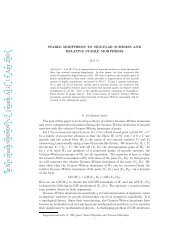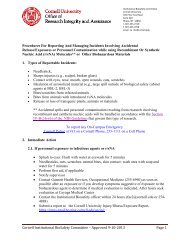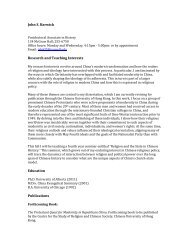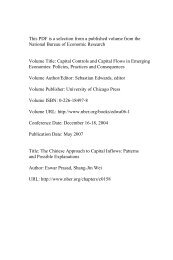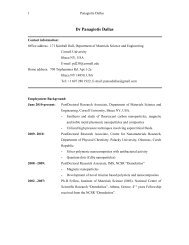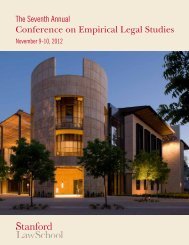Some basic results on Sturmian words
Some basic results on Sturmian words
Some basic results on Sturmian words
Create successful ePaper yourself
Turn your PDF publications into a flip-book with our unique Google optimized e-Paper software.
We’ll show that in fact there’s exactly <strong>on</strong>e splitter of each length. Since<br />
a 1 . . .a n is a splitter whenever a 0 a 1 . . .a n is, this means there is an infinite<br />
binary sequence f 1 , f 2 , . . . such that for each n, the unique splitter of length<br />
n has the form f n f n−1 . . . f 1 . So the questi<strong>on</strong> is, what’s this mystery sequence<br />
f As it turns out, the answer is sitting right in fr<strong>on</strong>t of us. In this c<strong>on</strong>text,<br />
what’s the most natural infinite binary sequence we can think of Well, let’s<br />
try s(α, t). But for what value of t What’s the most natural real number<br />
we can think of Well, how about α That’s right, this mystery sequence<br />
f is n<strong>on</strong>e other than s(α, α)! In less dramatic terms, that’s s(α, 0) with the<br />
initial 0 truncated. Thus<br />
Theorem 2. For each positive integer n, there is exactly <strong>on</strong>e splitter of<br />
length n, namely s n+1 (α, 0)s n (α, 0)...s 2 (α, 0).<br />
Proof. Since we’ve already shown that there is at most <strong>on</strong>e splitter of<br />
length n, we need <strong>on</strong>ly show that s n+1 (α, 0)s n (α, 0)... s 2 (α, 0) is in fact a<br />
splitter. To do this, choose ǫ > 0 small enough so that s(α, 0) and s(α, 1 −ǫ)<br />
coincide to the first n + 1 places, excluding the first place. Note that for<br />
sufficiently small ǫ, they do not coincide at the first place: s 1 (α, 0) = 0, while<br />
s 1 (α, 1−ǫ) = 1. By Theorem 1, this means that both 0s 2 (α, 0)...s n (α, 0)s n+1 (α, 0)<br />
and 1s 2 (α, 0)...s n (α, 0)s n+1 (α, 0) are in D α . Since D α is preserved under reversal,<br />
s n+1 (α, 0)s n (α, 0)... s 2 (α, 0) is a splitter.<br />
As trivial as it seems, truncating the initial 0 from s(α, 0) is in some<br />
strange way the key to the proof.<br />
Since there’s exactly <strong>on</strong>e splitter of each length, the number of <strong>words</strong> of<br />
length n in D α is always <strong>on</strong>e more than the number of <strong>words</strong> of length n −1,<br />
which gives us the following rather counterintuitive result.<br />
Corollary. The number of <strong>words</strong> of length n in D α is n+1, independent<br />
of α.<br />
What is the significance of these <str<strong>on</strong>g>results</str<strong>on</strong>g> In some sense, the sequence<br />
s(α, 0) (or, if you like, s(α, α)) tells us everything we could ever want to<br />
know about D α . Not <strong>on</strong>ly does it describe D α as a set (Theorem 1), it also<br />
encodes the complete structure of D α as a tree (Theorem 2).<br />
4




